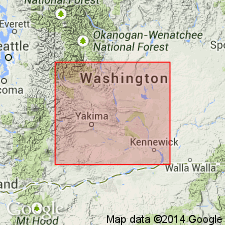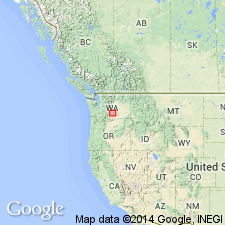
- Usage in publication:
-
- Beverly Member
- Modifications:
-
- Original reference
- Dominant lithology:
-
- Basalt
- Pumice
- Conglomerate
- AAPG geologic province:
-
- Eastern Columbia basin
Summary:
Pg. 26-29, 31, 33. Beverly Member of Ellensburg Formation. Term "Beverly" originally used by Twiss (1933, unpub. thesis) for a pumicite bed in sedimentary rocks beneath Saddle Mountains Basalt Member (new) of Ellensburg Formation in Sentinel Gap section, is here redefined to include all sedimentary rock and intercalated basalt between top of Yakima Basalt and base of Saddle Mountains in that section. Conglomerate that makes up most of Beverly Member consists of: pebbles of varied felsite porphyries; granitic and metamorphic rocks; basalt; and gray, pink, and purple quartzite. Includes 3 lava flows, described as dense, black, and very fine-grained with rare plagioclase phenocrysts as much as 2 mm in length. Flows are characterized by jointing habit. Underlies Saddle Mountains Basalt Member of Ellensburg Formation. Overlies Priest Rapids Basalt member of Yakima Basalt. A tongue of basalt here designated Huntzinger flow fills a valley cut in upper part of Yakima Basalt during Beverly time.
[Probably named for Beverly, Grant Co., WA.] Sentinel Gap section is in Vantage-Priest Rapids area, south-central WA.
Source: US geologic names lexicon (USGS Bull. 1350, p. 62-63); GNU records (USGS DDS-6; Menlo GNULEX).

- Usage in publication:
-
- Beverly Member*
- Modifications:
-
- Principal reference
- Adopted
- Dominant lithology:
-
- Pumicite
- Fanglomerate
- Conglomerate
- Sand
- Silt
- Clay
- AAPG geologic province:
-
- Eastern Columbia basin
Summary:
Pg. G13-G14. Beverly Member of Ellensburg Formation of Mackin (1961, Washington Div. of Mines and Geol. Rpt. Inv., no. 19, 45 p.) is adopted by the USGS. At type, consists of beds of quartzite-bearing conglomerate pumicite, and tuffaceous sand, silt, and clay. At Sentinel Gap the quartzite-bearing conglomerate and pumicite compose about 160 feet of the total 300 feet. In scattered outcrops, member may include basaltic fanglomerate, as well as conglomerate, pumicite, tuffaceous sand, silt, and clay. May be considered a lithosome consisting of mutually intertonguing lithostratigraphic units, any one of which may predominate or be present to the exclusion of the others at one locality. In Yakima area, the 200+/- feet of sedimentary deposits which underlie the Saddle Mountains Member was named the †Selah Tuff Member by J.H. Mackin (1947 [abs.], Northwest Science, no. 1, p. 33). In 1961 Mackin (Washington Div. Mines and Geol. Rept. Inv. 19) named the 300+/- feet of sedimentary deposits and basalt flows under the Saddle Mountains Member at Sentinel Gap the Beverly Member of Ellensburg. Name Beverly Member is here given to the sedimentary deposits below top of uppermost Saddle Mountains flow and above Priest Rapids Member. Name †Selah Tuff Member is abandoned. Type locality noted. Age of Ellensburg Formation is from late Miocene to early Pliocene, based on fossil evidence (citing Smiley, 1963, Ellensburg flora, Univ. Calif. Pub. Geol. Sci., v. 35, no. 3, p. 206).
Type section is southeast of Sentinel Gap, in NW/4 sec. 23, T. 15 N., R. 23 E., Grant Co., WA. Is known to extend eastward as far as Drumheller and Othello channels and southward as far as Umatilla, OR.
[GNC remark (ca. 1970, US geologic names lexicon, USGS Bull. 1350, p. 63): The USGS currently designates the age of the Beverly Member as late Miocene and early Pliocene on basis of study now in progress (see also USGS Bull. 1254-A, p. A5).]
Source: US geologic names lexicon (USGS Bull. 1350, p. 62-63); Changes in stratigraphic nomenclature, 1966 (USGS Bull. 1254-A, p. A5); GNU records (USGS DDS-6; Menlo GNULEX).

- Usage in publication:
-
- Beverly Member*
- Modifications:
-
- Age modified
- Biostratigraphic dating
- AAPG geologic province:
-
- Eastern Columbia basin
Summary:
Pg. G5, G8, G36. Beverly Member of Ellensburg Formation. Age is considered middle Miocene based on stratigraphic relations. Overlies Priest Rapids Member of Wanapum Basalt at Priest Rapids Dam, central Washington (citing R.D. Bentley, 1977, IN Brown and Ellis, eds., Geol. excursions in Pacific Northwest, Western Washington Univ. Press, p. 339-389). Reinterpretation of vertebrate fossils (C.A. Repenning, USGS, written commun., 1977) restricts age of Ellensburg Formation to Miocene; Miocene-Pliocene boundary placed at 5 Ma.
Source: Publication; GNU records (USGS DDS-6; Menlo GNULEX); GNC index card files (USGS-Menlo; USGS-Reston).
For more information, please contact Nancy Stamm, Geologic Names Committee Secretary.
Asterisk (*) indicates published by U.S. Geological Survey authors.
"No current usage" (†) implies that a name has been abandoned or has fallen into disuse. Former usage and, if known, replacement name given in parentheses ( ).
Slash (/) indicates name conflicts with nomenclatural guidelines (CSN, 1933; ACSN, 1961, 1970; NACSN, 1983, 2005, 2021). May be explained within brackets ([ ]).

